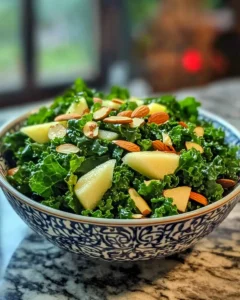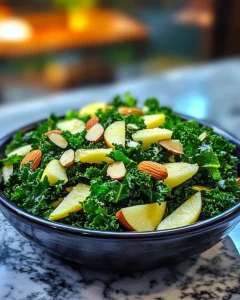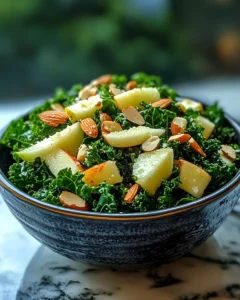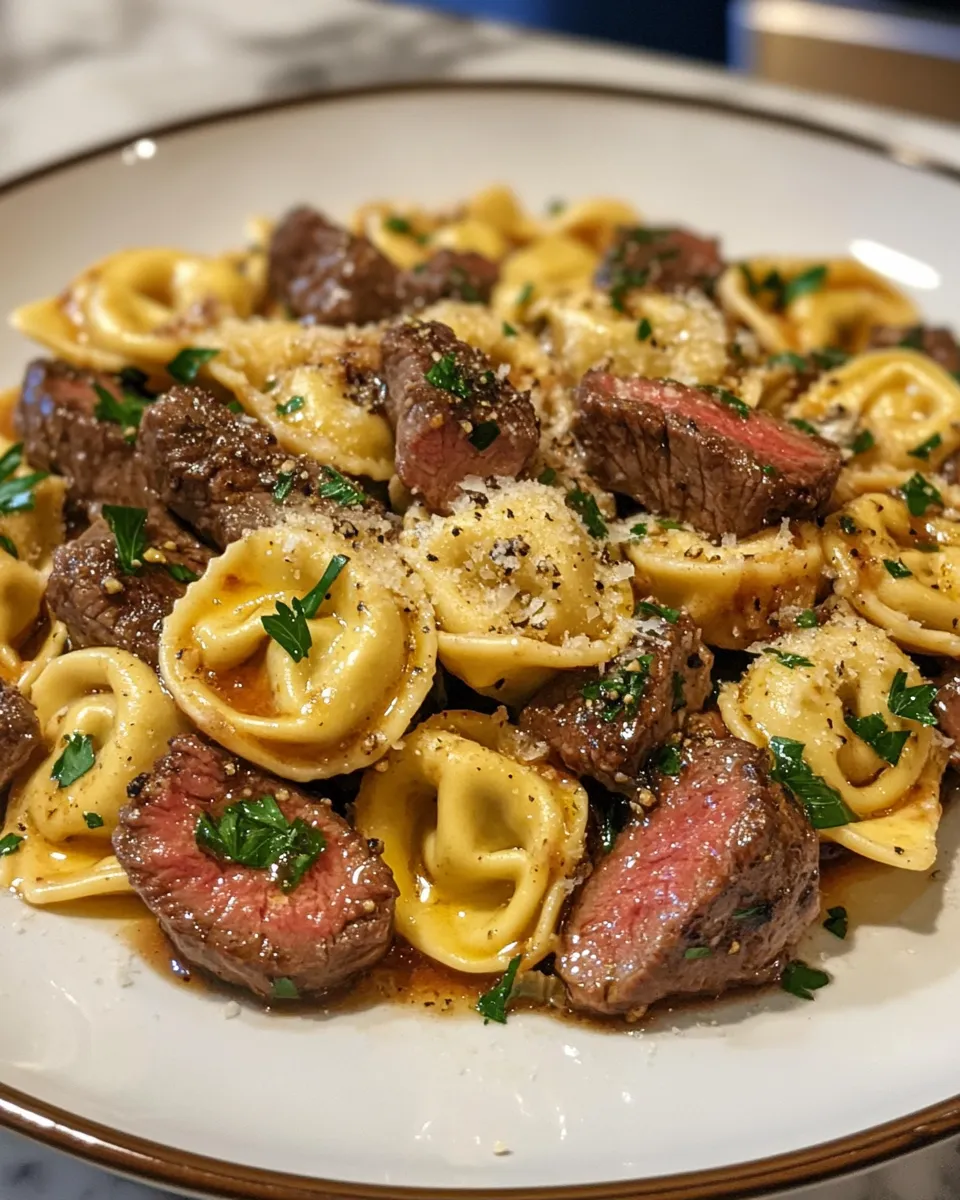There are certain dishes that feel timeless, effortlessly bridging the gap between health-conscious eating and satisfying comfort food. Kale Salad with Apples & Toasted Almonds is one of those dishes—a salad that shines at both casual weekday lunches and festive gatherings. It’s crisp, vibrant, and layered with flavors that make even skeptics of kale take a second bite.
This recipe was inspired by the wholesome flavors of fall, when apples are at their juiciest and leafy greens are abundant. It’s the kind of dish you can picture at a family dinner during apple-picking season or served as a refreshing side at a holiday table. The toasted almonds add warmth and crunch, while a tangy dressing brings everything together into a dish that feels both nourishing and indulgent.
Whether you’re preparing this salad as a light lunch, a potluck contribution, or a side to a hearty main, it’s a recipe you’ll want to keep in rotation all year long.
Why You’ll Love This Kale Salad
Before diving into the step-by-step instructions, let’s highlight why this salad deserves a spot on your table:
-
Flavor Balance: The earthy kale pairs beautifully with the sweetness of crisp apples and the nuttiness of toasted almonds.
-
Nutrient-Rich: Packed with vitamins, minerals, fiber, and healthy fats, it’s as good for your body as it is for your taste buds.
-
Versatile: Works as a main dish with added protein, or as a refreshing side dish alongside roasted meats, soups, or grain bowls.
-
Meal-Prep Friendly: Kale holds up well, so you can prep this salad in advance without worrying about it wilting quickly.
Ingredients You’ll Need
To make this kale salad with apples and toasted almonds, gather the following ingredients:
-
Kale: About 1 large bunch or 5–6 cups chopped. Choose curly or lacinato (Tuscan) kale.
-
Apples: 2 medium apples, preferably crisp and sweet varieties like Honeycrisp, Gala, or Fuji.
-
Almonds: ½ cup sliced or slivered almonds, toasted until golden.
-
Red Onion: Thinly sliced for sharpness and color contrast.
-
Dried Cranberries or Raisins (optional): Adds a burst of sweetness.
-
Cheese (optional): Crumbled feta or shaved Parmesan for a creamy, savory touch.
For the Dressing:
-
¼ cup extra-virgin olive oil
-
2 tablespoons apple cider vinegar
-
1 tablespoon Dijon mustard
-
1 teaspoon honey or maple syrup
-
Salt and pepper to taste
Step-by-Step Instructions
1. Prepare the Kale
The foundation of this salad is fresh kale, and preparing it properly makes all the difference in taste and texture. Begin by rinsing the leaves thoroughly under cold running water to remove any grit, dirt, or hidden garden soil. Even if your kale looks clean from the store or farmers’ market, it’s worth giving it a careful wash. After rinsing, pat the leaves dry with a clean kitchen towel or spin them dry in a salad spinner to ensure they aren’t holding excess water, which can dilute the dressing.
Next, focus on removing the tough, fibrous stems and ribs. These parts are too chewy and can overwhelm the salad if left in. Fold each leaf in half lengthwise and use a sharp knife to slice along the stem, or simply tear the leaf away by hand. Once the stems are removed, chop the kale into bite-sized pieces for easier eating.
Pro Tip: Kale has a naturally hearty texture that can feel too coarse if eaten raw without treatment. To improve its flavor and tenderness, massage the chopped leaves with a drizzle of olive oil or lemon juice. Rub the leaves gently with your fingertips for 2–3 minutes until they darken slightly and feel more pliable. This simple step softens the kale, reduces its bitterness, and brings out a sweeter, more enjoyable taste.
2. Toast the Almonds
Toasted almonds are the crunchy, nutty element that elevate this salad. Start by placing a dry skillet on the stovetop over medium heat. Once the pan is warm, add your sliced or slivered almonds in a single layer. Stir them frequently to prevent uneven browning.
As the almonds toast, they’ll release a fragrant aroma and turn a light golden color. This process usually takes about 3–5 minutes, but it’s important to stay attentive. Nuts can go from perfectly toasted to burnt in seconds, and a bitter almond can throw off the balance of the salad. As soon as the almonds reach a golden hue, remove them from the pan and transfer them to a plate or bowl to cool. Leaving them in the hot skillet will cause them to continue cooking.
3. Slice the Apples
The apples bring crisp sweetness and juiciness to balance the earthy greens and savory toppings. Wash and dry them thoroughly, then decide whether you prefer thin slices or small bite-sized cubes. Both options work well—slices make for a more elegant presentation, while cubes offer a satisfying crunch in every forkful.
To prevent browning, which happens when apples are exposed to air, toss the slices or cubes with a few drops of fresh lemon juice. This not only keeps them looking fresh but also adds a subtle tang that enhances the overall flavor.
4. Make the Dressing
The dressing ties the salad together, offering brightness and balance. In a small bowl or jar, whisk together the extra-virgin olive oil, apple cider vinegar, Dijon mustard, honey, salt, and black pepper. Continue whisking until the mixture emulsifies into a smooth, slightly thickened consistency.
Taste the dressing before adding it to the salad and adjust to your preference. If you prefer a sweeter profile, add a touch more honey. For extra tang, increase the vinegar. A pinch more salt can bring out all the flavors, while freshly cracked black pepper adds a mild kick.
5. Assemble the Salad
Now it’s time to bring everything together. Place the massaged kale in a large mixing bowl. Add the sliced apples, thinly sliced red onion, and, if you’re including them, dried cranberries or raisins for extra pops of sweetness. Drizzle the prepared dressing evenly over the top.
Using salad tongs or clean hands, toss everything thoroughly until the kale is coated and the toppings are evenly distributed. Make sure each leaf of kale has a light sheen of dressing, as this ensures maximum flavor in every bite.
6. Add the Almonds and Cheese
For the finishing touches, sprinkle the cooled toasted almonds over the salad. These add a satisfying crunch and depth of flavor. If you enjoy cheese in your salads, now is the perfect time to add it. Crumbled feta offers a creamy, tangy note, while shaved Parmesan brings a nutty, savory sharpness. Both pair beautifully with the apples and kale.
You can either toss the almonds and cheese gently into the salad for even distribution, or leave them artfully arranged on top for a more polished presentation. Serve immediately, or let the salad rest for 5–10 minutes to allow the flavors to meld before enjoying.
Serving Suggestions
This kale salad is versatile enough to serve on many occasions. Here are some pairing ideas:
-
As a Side Dish: Perfect alongside roasted chicken, grilled salmon, or a holiday roast.
-
As a Main Dish: Add grilled chicken, baked tofu, or chickpeas for a protein boost.
-
For Entertaining: Serve it on a large platter at a dinner party, potluck, or holiday meal.
-
For Meal Prep: Store leftovers in an airtight container; the kale stays fresh longer than most greens.
Nutritional Benefits
Kale isn’t called a superfood without reason. This salad combines powerhouse ingredients that make every bite both tasty and nourishing:
-
Kale: Rich in vitamins A, C, and K, along with antioxidants and fiber.
-
Apples: A great source of dietary fiber and natural sweetness.
-
Almonds: Provide healthy fats, plant-based protein, and vitamin E.
-
Olive Oil: Adds heart-healthy monounsaturated fats.
Together, these ingredients make a dish that supports digestion, boosts immunity, and sustains energy throughout the day.
Variations to Try
The beauty of this kale salad lies in its adaptability. Here are some fun twists you can experiment with:
-
Fruit Swaps: Replace apples with pears, pomegranate seeds, or oranges for a seasonal twist.
-
Nut Options: Use walnuts, pecans, or pumpkin seeds instead of almonds.
-
Cheese Choices: Try goat cheese, blue cheese, or even shredded sharp cheddar.
-
Grain Boost: Add cooked quinoa, farro, or brown rice for extra heartiness.
-
Protein Additions: Toss in shredded rotisserie chicken, grilled shrimp, or roasted chickpeas for a complete meal.
Make-Ahead Tips
If you’re preparing this salad for an event or meal prep, here’s how to keep it fresh:
-
Prep Ingredients Separately: Store chopped kale, sliced apples (tossed with lemon juice), toasted almonds, and dressing in separate containers. Combine just before serving.
-
Dress with Caution: If making ahead, add the dressing to the kale first—it can withstand sitting in dressing without getting soggy, unlike lettuce. Add apples and almonds right before serving.
-
Storage: Leftover salad can be stored in the fridge for up to 2–3 days. The kale will stay crisp, though apples may soften slightly.
Frequently Asked Questions
1. Can I use baby kale instead of regular kale?
Yes! Baby kale is a wonderful substitute if you’re not a fan of the hearty texture of mature kale. Its leaves are smaller, more tender, and naturally milder in flavor. Unlike regular kale, baby kale doesn’t require massaging because it’s already soft enough to enjoy raw. This makes it a convenient choice for busy weeknights when you want to cut down on prep time. Keep in mind, however, that baby kale is more delicate and won’t hold up quite as well to storing once dressed, so it’s best enjoyed fresh.
2. What kind of apples are best for this salad?
The type of apple you choose will influence the overall flavor balance of the salad. Crisp and slightly sweet-tart apples work best because they provide both crunch and brightness. Honeycrisp, Fuji, and Gala apples are excellent for their juicy sweetness, while Granny Smith adds a refreshing tang and extra bite. If you’re making this salad for a group, mixing two apple varieties can add complexity and keep each bite interesting.
3. Can I make this salad nut-free?
Absolutely. If you have a nut allergy or simply prefer not to use almonds, there are plenty of alternatives. Sunflower seeds, pumpkin seeds, or crunchy roasted chickpeas all provide a similar texture and satisfying crunch. These substitutions also make the salad more accessible for school lunches or gatherings where nut allergies might be a concern.
4. How do I keep apples from browning?
Apples naturally oxidize when cut, which causes them to turn brown. To keep them looking fresh, toss the slices in a teaspoon or two of lemon juice, or soak them briefly in a bowl of water mixed with lemon juice. This simple step preserves their color and ensures your salad looks as appetizing as it tastes.










